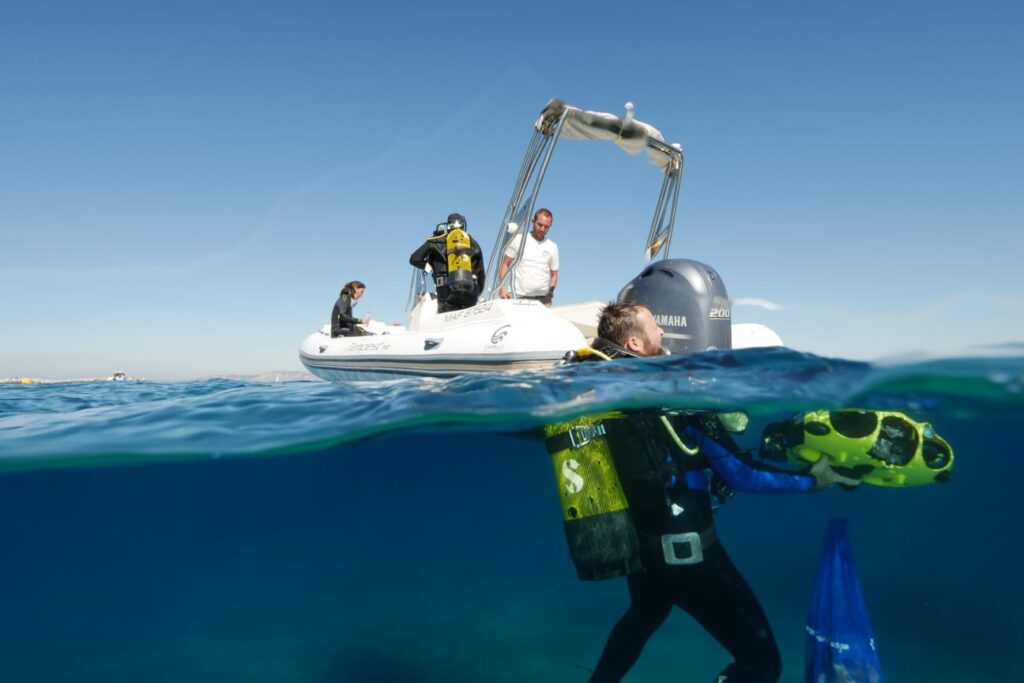
- May 4, 2022
- Théo Cartereau
- Underwater drone news
- 0 Comments
Seasam & iBubble, the underwater drones to perform ocean cleanups
For a few years, local ocean cleanup dives has grown in popularity among scuba divers. Witnessing the effect of man-made pollution on their “house” reefs & dive sites, divers worldwide take action. Ocean cleanups have picked up in popularity amongst divers. Groups of divers join forces in polluted areas to clean them up by picking up litter, discarded tires, washed up plastics… Some divers during these dives wanted to work smarter, not harder: so why not using underwater drones?
As you might already know, Seasam and iBubble have the unique ability to follow a diver autonomously underwater. During underwater drone ocean cleanup dives, cleaners can set up one of our drones to provide great visual content to the organizers, and to increase the visibility and impact of the event. But wait, there’s more!
Did you know that both the Seasam and iBubble drones can carry a payload of up to 2 kgs underwater? This has unexpected benefits, as our team demonstrated during a combined beach & bay cleanup held in Baie des Catalans, Marseille, France.
Collected waste can quickly become heavy underwater, and it’s always good having someone – or something! – giving a hand… So let Seasam, or iBubble become your underwater mule and carry your load, and then pick up some more!
Now obviously, this is a very special and advanced way of using our drones, and you are going to push the boundaries of its usage… Our team members Romain and Thibaut have gathered some practical tips for you from their multiple experiences using Seasam as a mule. Read on!

PRE-DIVE
Set your drone altitude-to-diver higher than usual.
This way, when your mule is loaded, the bag below won’t touch the bottom. Since the drone’s depth is dictated by the underwater remote control in or close to your hand, and your hands will be busy picking up things from the bottom, this will drive the drone deeper. So by setting the drone way higher than usual, you prevent your bag from touching the sea floor.
Tilt your camera down (for iBubble).
That’s a logical step resulting from the above. Since your drone is higher compared to the diver, orient your GoPro to look more down than usual in order to keep you in focus.
Which bag to use?
Light mesh bags with a long rope and a simple tightener are best. For example, the bags from our friends at “Un Ocean de Vie”.
DURING THE DIVE
Disable Obstacle avoidance
With your UW remote in Mode/Obstacle. Drone will blink thrice to show the function is turned off. Once your bag fills up, the accumulated thrash below the drone could be seen as an obstacle and trigger the avoidance behavior unnecessarily.
Set your drone to the Close distance.
This way you will not waste time fetching it if you need to put additional garbage in the bag.
Once your first bag of trash is half-full or full, attach it to your drone. Select the Stay scenario, get closer to your drone and make sure to keep your fingers away from any propeller – safety first!
Simply hang the rope’s loop to one of the side handles, twist the rope once and then hang the rest of the rope to the second handle. This way your bag will be nicely centered below your mule!
Caution: do not hang an empty net under the drone as it could be sucked in by the propellers and get damaged, as well as damaging your propellers.
Give your mule a break.
Your drone will carry a heavy load , which can drain your battery faster. So, ideally, if you dive from a boat at the surface, you can get back under to the boat, and then select the Surface scenario to send your mule to your surface buddy for unloading the thrash. Just hover nicely in the meantime, and put your drone in follow mode again to bring it back to you.
Stick to the “Follow scenario” when carrying a heavy load.
The weight will use up your battery faster, so stick to “Follow” which is the most energy efficient.
You can also use the “Stay” mode if you are working longer on the same spot, in calm conditions (no current).
When you finish your dive and surface, put the drone in Stay mode, and make sure you are ready to hold it and its heavy bag before disarming, otherwise your drone will sink because of its load…

POST DIVE
Rinse your drone more thoroughly than usual.
Chances are, you were doing your underwater drone ocean cleanup in an area in which the water carries debris. So pay extra attention to any small debris that could be stuck near your propeller, under your hull, etc…
Have you participated in a underwater drone ocean cleanup dive? Share and spread the love!
We love seeing our products be put to such a good use.
And you, what are your tips and tricks for diving with our drones? Share them in the comments below! Also, we would love to hear your own tips and suggestions.
Please share them in the comments section here.
JOIN US ON OUR NEXT CLEAN-UP!
We will take part in the “Calanques Propres” operation on June 4th – so if you happen to be not far from Marseille, come dive with us and our underwater mule!

